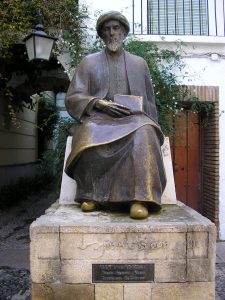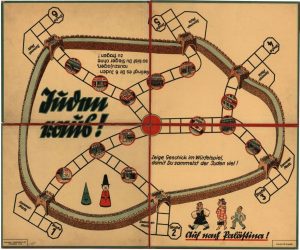45 Outline of Jewish History
Foundations of Jewish Historical Identity: 1400 BCE to 70 CE
The ancient Hebrews called their god Yahwheh (YHWH in Hebrew). The Hebrews sacrificed to other gods, but were as they considered Yahweh to be above the other gods. The Hebrews developed portable rituals and altars to fit their nomadic life. As the Hebrew religion developed covenants with Yahweh, a form of ethical monotheism, they built a portable wooden chest called the Ark of the Covenant to preserve the commandments of God.

The first reference to people known as Israelite comes from an Egyptian stone inscription from 1207 BCE. Modern archaeology has uncovered evidence of small, ancient villages of the Israelites dating back to the thirteenth and fourteenth centuries BCE.
By the tenth century BCE, the Israelite had conquered a region of Canaan and established an Israelite kingdom known as the United Monarchy. The city of Jerusalem was its capital. The United Monarchy was a collection of Israelite tribes united together as a political unit.
According to the Torah, one of the main religious texts of Judaism, King David was one of the first kings of the United Monarchy. In the years that followed Kind David’s rule, the Israelites built a great temple in Jerusalem to house the Ark of the Covenant. The temple became a central, permanent place both for the Ark of the Covenant, and for the worship of God. From this point forward, the Israelites (and later, the Jews) looked primarily to the temple in Jerusalem as the geographical and spiritual center of their religion. According to the Torah, David was a great leader, and made a prosperous kingdom during his rule. During this time, the religion of the ancient Hebrews became a religion of an established people. By 922 BCE, however, the kingdom divided into a northern kingdom called Israel and a southern kingdom called Judah. For two hundred years the two kingdoms maintained control of their region.
In 722 BCE, Israel was conquered by the Assyrian empire, and Israelites scattered throughout the region. Eventually Judea too was conquered. The first temple, built during the United Monarchy, was destroyed in 586 BCE and the Israelites were taken into captivity in Babylon. At this point, the Israelites came to be called “Jews” – those who were from the region of Judea. Fifty years later the Persian ruler King Cyrus allowed the Jews to return to Jerusalem and they rebuilt the Temple in 515 BCE. For the next 500 years they controlled the temple, but they never regained their kingdom and were continually under foreign control. Most Jews were dispersed throughout the Mediterranean region. During this period the ancient religion of the Hebrews absorbed ideas from their conquerors, such as Persian beliefs about the afterlife.
It was not until 164 BCE that the Jews were able to establish Israel as an independent kingdom due to the success of the Maccabean rebellion. During the next hundred years, three different sects within Judaism developed: the Sadducees, the Pharisees, and the Essenes. The wealthy Sadducees emphasized law and the proper worship of God. The Pharisees focused on the application of the Jewish teachings to the everyday lives of Jews. The Essenes focused on moral and ritual purity and spoke out against what they thought were the excesses of the priesthood.
Conflict between these groups during this time led to a splintering of Jewish allegiances. Apocalyptic literature depicting the end of the current world and God’s punishment of wrongdoers flourished. Many Jews hoped that a strong king would come to unite the Jews once more. This figure, who would be anointed as a messiah, would come to end the difficulties that the Jews faced and bring them back to power in Israel. Some Jews interpreted the messiah as the return of a spiritual leader who bring the Jews back into God’s favor. [For more discussion of the concept of messiah, see the Christianity chapter.]
In the first century CE, a second Jewish War with Rome ended in defeat. The Romans destroyed the second temple in 70 CE. The remains of the temple, became known as the “wailing wall,” a sacred site of pilgrimage for Jews to this day.
Diaspora and Exegesis: c. 70 to 1949 CE
In the early history we saw the major themes of Judaism. First, there is a longing for a kingdom and a sacred land promised to them by their God, Yahweh, through his covenant with Abraham. Second, there was the historical reality of periods of relative peace and autonomy followed by occupation and captivity. Exile from their sacred land was a recurring theme. In the Narrative section below we will investigate the religious meaning that Jews give to these historical events. In this section, we will examine some of the developments in Jewish history that helped Jews retain a sense of religious identity and yet accommodate their faith to new cultures in which they thrived.
The exile from Jerusalem at the hands of the Romans led to another shift in emphasis in Jewish life and religious practice. Jews began living in the diaspora, which means living outside of their homeland, Israel. A group of people known as rabbis became the center of Judaism. These rabbis were from the tradition of the Pharisees and sought to comprehend the importance of the Torah in everyday life. This process of critically exploring the Torah is known as exegesis. They took this searching for meaning and used it to reinterpret the expulsion of the Jews from Jerusalem. During this time, the rabbis gathered and finalized the books of the Tanakh, a collection of Jewish sacred texts and declared it to be closed to future revelation.
A tradition of interpreting these scriptures emerged known as Midrash. Midrash interpreted the meaning of scriptures and identified the correct laws by which Jews ought to live their lives. Much discussion and debate grew around Midrash, which led to extensive commentaries. This large body of commentaries, known as the oral Torah, was eventually compiled in written form and named the Mishnah.
The process of exegesis, helped to introduce many new concepts into Judaism. Rabbis were able to reorient religious practice to suit new conditions. The synagogue became the center of religious life instead of a geographically located kingdom. Though the Jews never forgot the central importance of Jerusalem, they began to restructure their spiritual lives around focal points in their new homes in the diaspora.
Rabbinic Judaism also shifted the religious practice away from the ritual sacrifices to YHWH that characterized the first and second temple periods. In place of sacrifice, rabbis emphasized prayer as the primary way to worship God.
Medieval Judaism (c. 500-1500 CE)
Judaism thrived in many different parts of the world during the thousand years from 500-1500 CE. As the Jews continued to disperse throughout the world, different cities arose as the centers of Jewish life. Babylon, which produced two important rabbinical academies, became an important city for the intellectual development of the Jewish diaspora. Baghdad became a center of Jewish craftsmen and merchants. Judaism, despite being a diaspora religion scattered over great distances, maintained a remarkable amount of cultural unity during this period.
The Jews experienced varying degrees of tolerance and acceptance by the local communities in which they settled. In some Western European countries, Jews were viewed with suspicion, and were forced to live in ghettos, closed off by walls from the rest of the community. Throughout European history, there are many instances of Christian mobs attacking Jews, as well as forcing Jewish population to migrate elsewhere. In other places that they settled, Jews were accepted to a much greater degree, such as in Eastern Europe. As Islam spread throughout the Near East and into North Africa and the Mediterranean region, the Jews who came under Muslim rule were treated with a relatively large amount of tolerance compared with Christian Europe. An important center of Jewish life in Europe emerged in Spain under Muslim rule.

Maimonides (1135-1204), a Spanish philosopher and physician, was one of the most famous Jewish intellectuals of the Medieval period. He created a rational approach to Jewish religious concepts that built on rabbinical exegesis. He argued that the truths of God can be discovered in the natural world. Maimonides drew on Christian and Muslim philosophy by emphasizing the transcendent nature of God, separate from the world of humanity. While his approach was not accepted by all Jews at the time, the way Maimonides approached Judaism led to lively debate among scholars during the Medieval period. Maimonides’ scholastic approach was highly influential in the development of Jewish theology and has influenced Judaism down to the present day.
In contrast to the rational approach of Maimonides rational, a mystical Jewish tradition, the Kabbalah, developed during the Medieval period. The Kabbalah was secret knowledge designed to uncover hidden aspects of God. Words from the Torah were assigned symbolic value, with each word corresponding to one of ten divine powers. Using this system, practitioners of Kabbalah could read the Torah in radically new ways than traditional Rabbinical exegesis. Ideas of the mystical dimensions of the Torah were explained in various books, the most famous of which was known as the Zohar. It is from this emphasis on the mystical that there developed within Judaism an emphasis on heartfelt emotion and simple devotion to God over reason and intellect.
Modern Judaism (c. 1500-1948 CE)
Two factors influenced Judaism and other religions in Europe during the sixteenth to eighteenth centuries. A movement known as the Enlightenment championed rational inquiry and the separation of supernatural and religious elements from social institutions like government. This movement to separate government from religion fostered religious tolerance. Jews living in Europe during this time period benefited from this increase in religious tolerance.
The ideas of the Enlightenment also caused many Jews to begin to question aspects of Judaism. In the nineteenth century, reform Judaism became more inclusive, redesigning Jewish religious practices to resemble Christian religious practices of the mainstream European population. Those who opposed the influence of secularization and reform were labeled Orthodox Jews.
Yet there were dangers in the modern world as well. Political and economic turmoil in twentieth-century Germany put many European Jews in great danger. Anti-Jewish sentiment had long been prevalent in Christian Europe, and during certain time periods, Jews were scapegoated for the problems of Europe. A scapegoat is a person or group who is blamed for the faults or mistakes of another person or group.
Nazi leader Adolf Hitler rose to power Germany in the 1930s. He blamed Jews for many of the problems of the German people. As Hitler and the Nazi party rose to power, millions of Jews were displaced and made to live in ghettos, wearing badges that indicated that they were Jews. They were eventually forcibly removed to concentration camps, where they were forced to work. Many Jews were killed in the gas chambers of the concentration camps.
Although the Allied powers eventually overtook the Nazis, it was too late to save many of the Jews in concentration camps. Altogether, more than 6 million Jews were killed by the Nazis during WWII. This period is known by Jews as the Holocaust, a name derived from the ancient Israelite sacrificial offerings to God.

The horrors of the Holocaust led the Allied powers to establish the country of Israel. Jews reasoned that the only way for them to be truly safe from something like the Holocaust was for them to have their own political power. This idea, known as Zionism, was first proposed in the 1800s but took on new significance in the wake of World War II. As a result, the Allied powers gave the Jews land in Palestine that corresponded roughly to the land of Canaan promised to the Hebrews in the Torah. While the establishment of Israel as an independent country satisfied those in favor of Zionism, it caused friction between the Jews and the Islamic Palestinian population that had been living in the region for centuries. This conflict between Jews and Palestinians continues to the present day.
Today, Judaism is a religion practiced all around the world. While most Jews still practice their religion in the diaspora, many migrated back to Israel after it was officially made a country in 1948. Today, there are about 14.5 million Jews, with a Jewish population around 6.5 million living in Israel, and 5.7 million living in the United States. There are a wide variety of Jewish practices and orientations. The reform and orthodox spectrum of Jewish orientations have continued to inspire new practices and directions.
Judaism has continued to change into the contemporary period. For instance, Judaism in the contemporary world is no longer only a religious designation, but also an ethnic one – that is to say, a person can be Jewish in terms of their heritage, but not religious.
Another aspect that has changed significantly is the role that women play within Judaism. Originally, women were responsible mostly for domestic affairs, including the religious education of children. Today, certain sects of Judaism are allowing for women to serve leadership roles, for instance, as rabbis.
